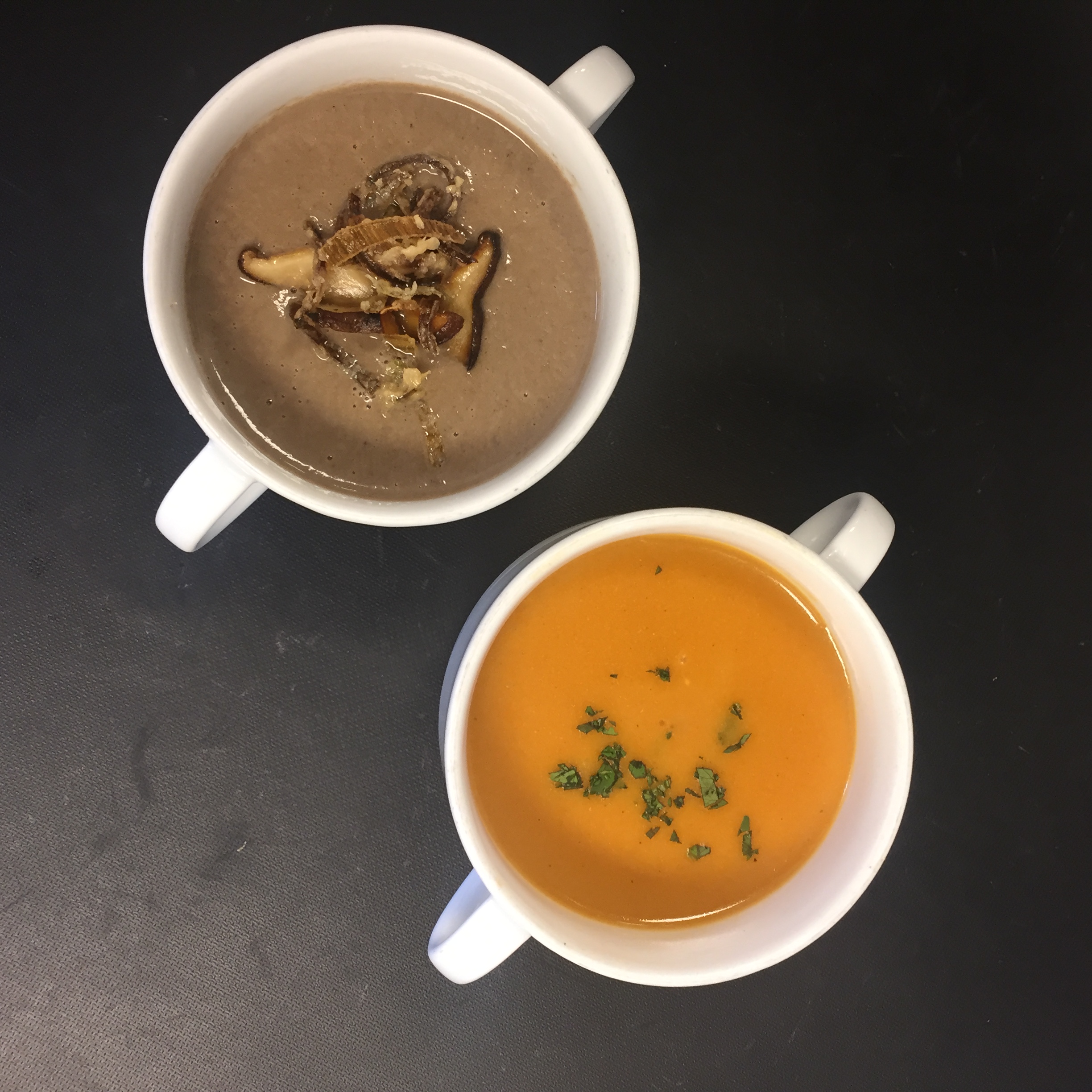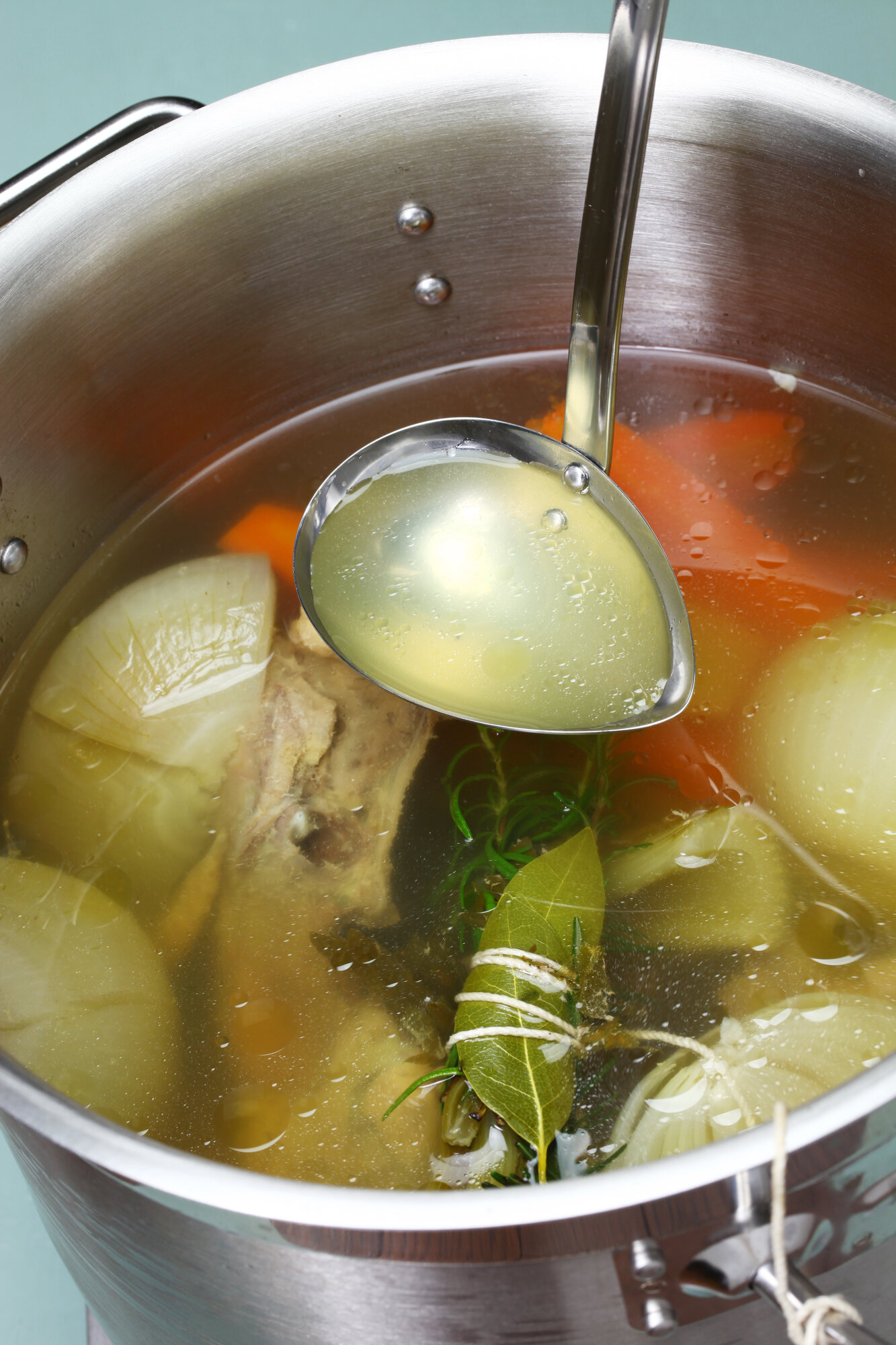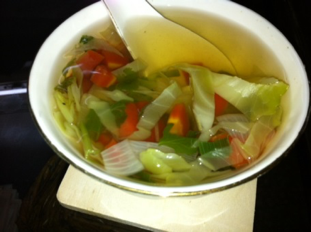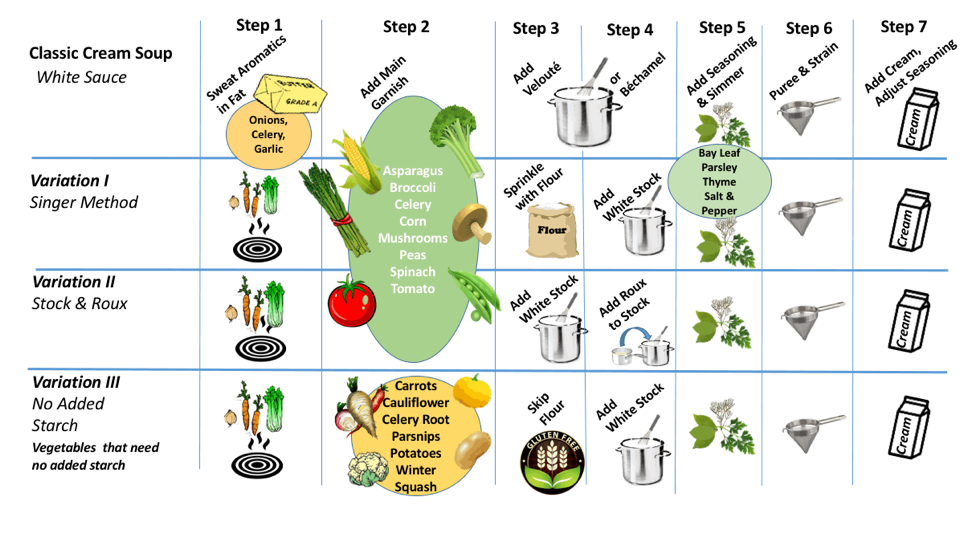Soups
Soups are either clear varieties based on broths and prepared stocks, or thick soups which are emulsified with starches and dairy products to give them more body. Soup categories also include ethnic or national soups based on popular cuisines including Minestrone, a hearty Italian vegetable soup, or Miso, a Japanese soup prepared with a light Dashi (seaweed) broth, as well as cold soups that essentially fall into thick or clear categories, including cold jellied consommés, or Vichyssoise, a cold puree of potato and leeks.
Clear Soups
A broth soup is cooked with meats, poultry, fish, or vegetables, and further enhanced with a combination of aromatic vegetables including onions, celery, and carrots (mirepoix), along with herbs and spices, including parsley, bay leaf, thyme, and peppercorns. Consommé’s are broths or stocks that are clarified with added meats and aromatics to enhance their flavor. Variations of these soups can be found throughout every culture today.
Broth Soup Flavor Profiles and Garnishes
Although a broth can be a simple preparation served by itself, hearty broth soups, garnished with additional vegetables, proteins, pasta, grains, legumes, spices and herbs, adds color, texture, and contrast to the finished product. The flavor of a broth soup varies, based on ethnic or regional preferences, such as a Borscht flavored with beets and cabbage and seasoned with marjoram, or a French Onion soup flavored with sherry and served with a cheese crouton.
Garnishes for broth soups should be cut uniformly to a bite-size that easily fits on a spoon, because too large of a garnish makes the soup difficult to eat. While vegetable garnishes can be cooked in the soup, other garnishes including pasta or grains, should be precooked before adding. To preserve their quality, add garnishes and added to the soup when plating.
Clear Soups
Broth and Stock-Based Soups
Basic Broth Soup
A simple white poultry broth is made by combining the poultry with cold water or a remouillage (second wetting of the stock). A premade stock (prepared from bones) may be used in place of the water to create a double strength broth. Similar to the preparation of a stock, the poultry is started in cold liquids so that as the proteins are heated the impurities are released into the liquid. As the soup comes to a simmer the impurities rise to the surface and are skimmed so the broth is clarified. Never allow the broth to boil, excessively because it creates a cloudy appearance. Once the soup has come to a simmer and clarified add a mirepoix and a sachet d’epice to enhance the flavor. Simmer to cook the proteins to develop a balanced flavor. Strain and garnish the broth as desired with diced poultry, fresh herbs, pastas, or grains. A broth soup is judged by the flavorful balance of the main ingredient (for example meat, poultry, or vegetables), aromatics, and seasoning. It should have proper clarity, free of excess floating particles. The color will vary from a golden hue for poultry and fish, to darker shades for beef or game.
Preparation Guidelines for Clear Stock-Based Soups
Cut vegetables uniformly
Add a minimal amount of oil or fat and sweat the vegetables until semi-soft
Add cold stock and seasonings; simmer until the flavor is balanced
Skim the surface periodically to remove impurities and excess fat
Use cooked proteins that are cut uniformly and add at the end of the cooking process
Starches, including pasta, rice, and other grains, are best when fully cooked and added at the time of service so they don’t swell and become waterlogged
Adjust seasoning to taste with salt, pepper, and avariety of spices and herbs
Consomme
Consommés are clarified and enriched to enhance their appearance by cooking a stock or broth with the help of a clearmeat raft, a mixture of lean ground proteins (for example beef, chicken, duck, game, or fish), egg whites, and mirepoix. The raft removes unwanted particles by filtering them through a fine mesh of coagulated egg whites, lean meat, and mirepoix, which also infuses the soup with extra flavor. The result is a crystal-clear liquid with a rich flavor and a slight gelatinous body.
Consommé Flavor Profiles and Garnishes
A consommé’s flavor profile is defined by the type of protein, chicken, beef, or pheasant for example, seasonings, and aromatic vegetables. Flavors profiles based on ethnic cuisines provide a variety of tastes, colors, and textures, so for an Asian chicken consommé you might include lemon grass and ginger in the raft and perhaps a dumpling with julienne vegetables for a garnish; a beef or duck consommé could be prepared in the style of a Borscht, with the addition of beets and marjoram to the raft garnished with beets, cabbage, potatoes, and dill; or an Indian curried lamb consommé might be prepared with the addition of garam masala seasonings (traditional Indian spice combinations) to a lamb meat raft and garnished with lamb meatballs, basmati rice, tomato concassé, and cilantro.
Garnishes of vegetables should be cut with precision to petite-sized brunoise or fine julienne, emphasizing the refined nature of the soup, and no larger than spoon size for ease in consuming. Grains including rice or barley, and delicate noodles or tortellini, add texture and hearty flavors. Classic French garnishes, including savory molded custards, add smooth and rich textures, while quenelles (mousseline forcemeat dumplings) add more substantial flavors. Fortified wines are another way to liven up the taste of a consommé. Sherry contributes a nutty flavor, Port wines a fruitier jam-like accent, and Madeira wines contribute sweet and spicy notes. Add these wines as a finishing touch, because they lose their flavor when exposed to prolonged heat. Fresh herbs add a final visual and flavor pop to a consommé. Garnishes should be free of excess fats or oils so use moist-heat methods to avoid surface grease that detracts from the appeal of the soup.
Consommé Preparation
Start with a well-flavored stock. The meat used in the raft depends on the type of consommé desired (beef, chicken, fish, game) and should be very lean. Use 3 lb./1.4 kg protein per 1 gallon/4 liters of consommé and add 1 lb./450 g of a standard mirepoix along with standard seasonings of parsley stems, thyme, bay leaves, and peppercorns,. An oignon brûlé (burnt onion) can be added to enhance the color along with tomatoes which also help to clarify the soup. For a fish or vegetable consommé, substitute lemon juice, vinegar, or wine for the tomato. The vegetables should be ground with the meat to extract the most flavor. Grind the proteins with the mirepoix and seasonings. Whisk egg whites to a froth and mix with the ground ingredients.
Combine with the cold stock and slowly heat to a simmer in a heavy-gauge pot. As it cooks the raft ingredients will sink to the bottom of the pot so be sure to gently stir to prevent sticking. As the consommé is heated the raft rises to the surface and clarifies (see illustration). Simmer for about 1 hour to enrich the flavor being careful not to break the raft once it forms on the surface. Taste the soup as it simmers and season to taste with salt and pepper. Once the flavor has been extracted strain the liquid without disturbing the raft through cheesecloth or a coffee filter, and skim excess surface fat. The soup can be chilled which solidifies the fat for ease in skimming , or for a hot consommé a paper towel can be drawn across the surface to absorb the fat (a less efficient method). Garnishes are added to the soup as it is being plated.
Puree Soups
Purée soups are prepared from dried legumes including beans, peas, and lentils, or they can be prepared with starchy root or gourd vegetables including carrots, potatoes, and butternut squash. These soups thicken by the process of suspension which happens through the release of starches in the vegetables during the pureeing process.
Garnishes should be paired based on the flavor profile of the soup. Croutons for texture, diced ham or bacon for salty, smoky, and umami flavors, and grated or shredded cheese for fatty flavors, are combinations that work well together in a split pea or bean soup. Acidic garnishes, including pickled vegetables of onions, sauerkraut, or kimchi, brightens the starchiness of a legume soup. Sour cream and crème fraiche provide richness and a touch of acidity for similar reasons. Fresh herbs, dried spices including cracked black pepper, infused oils, or toasted nuts are other options that add spicy or textural notes.
Purée Soup Preparation
Split peas and lentils for purée soups t need no prior soaking but beans may be soaked if desired (see cooking dried legumes in the vegetable chapter for more information on dried legumes). Use a ratio of 1-2 lb./450-900 g of legumes for 1 gallon/4 liters of soups. If the soups will be pureed to a smooth texture use the lesser amount, but if the beans are not use the higher amount.
Start by sweating a flavor base in fats or oils. Bacon or salt pork adds richness and pairs well with starchy beans, but for vegetarian soups use canola, olive, or coconut oil depending on the flavor profile desired. Add chili peppers (fresh or dried) to liven up the taste. Acidity is an important addition to purée soups because it lightens the starchiness on the palate. Tomatoes are often added for this reason, but because acids slow the softening of the cell walls preventing legumes from softening they should be added when the legumes are cooked to ¾ doneness. Similarly, citrus juice (lemon or lime), vinegar, and cultured cream (sour cream, yogurt, or crème fraîche) can also be incorporated but are usually added at the end of the cooking process or as garnishes.
Once the flavor base has cooked add the legumes or other main vegetable along with the liquid. If the beans were pre-soaked this liquid can be used or any type of stock including chicken, pork, ham, or vegetable. Beer pairs well with legumes too; choose a lighter lager for lentil soup and a robust ale for hearty black beans adding about 16 oz./500 ml for each 1 gallon/4 liters of soup.
Season with a standard sachet d’epice of parsley, bay leaf, thyme, and peppercorns, and enhance with heartier herbs; for example, rosemary or sage in a Tuscan bean soup; cayenne, coriander, and cumin in a Mexican black bean; or garam masala in an Indian red lentil soup. Salt reduces the swelling and softening of legumes so add it only after they become tender. Simmer the soup gently to limit evaporation of the liquid. Covering the pot with a lid reduces evaporation while and resulting in a creamier consistency. As the legumes cook they will begin to swell, soften, and break apart, causing the starches to disperse and thicken the liquid. Once they are cooked to ¾ tenderness add tomatoes and salt.Simmer until the legumes are fully tender and adjust the seasoning as desired.To thicken the soup puree all or part of it through a food mill, blender, or food processor.
Purée Soups with Fresh Vegetables
Purée soups made with fresh vegetables including roots and tubers like potatoes, carrots, and celery root, or winter squash, including pumpkin, acorn, and butternut squash, are prepared similar to cream soups and are covered in the section on cream soups.
Guidelines for Puree Soup Preparation
Use dried legumes, dense roots, gourds, or other starchy vegetables
Presoak dried beans prior to cooking
The natural starches in the vegetables will thicken the soup
Use any type of liquid desired, including poultry, pork, and vegetable stock, or water
Smoked meats, bacon, or pancetta provide a savory finish to the soup
Dried or fresh chilies add warmth to the palate
Puree part or all of the soup as desired; strain through a sieve if it is fully pureed
Cream is added to some pureed soups, particularly those prepared from root vegetables
Acidity (vinegar, lemon, tomatoes) will lighten the dull starchy taste on the palate
Adjust consistency with water or stock
Cream Soups
Cream soups can be prepared with classic sauces of béchamel or velouté, alternate methods include the use of a stock and prepared roux, or the substitution of starchy vegetables or other gluten-free thickeners in place of wheat flour. Vegetarian and vegan soup variations can be prepared using any of these methods.
Cream Soup Flavor Profiles and Garnishes
Before beginning a cream soup, decide on the flavor profile and main ingredient of the soup. For example, mushrooms, asparagus, or cauliflower; or proteins including chicken or fish. Often the garnish for a cream soup will be based on the main flavors, so for example broccoli florets may be used as a garnish for broccoli soup. The garnish should be uniformly cut so they cook evenly and precooked if necessary. To preserve their quality, prepare garnishes separate and add to the soup during plating.
Cream Soup Preparation
Start by sweating equal parts onions and celery (1 lb./450 g total for 1 gallon/4 liters soup) in butter or chicken fat. For vegetarian soups, oils like canola, olive, or coconut can be substituted depending on the desired flavor profile. Add other aromatic spices and flavorings including garlic, red chili flakes, or curry powder. Add the main ingredient such as tomatoes, broccoli, or mushrooms using about 3-4 lb./1.3-1.8 kg for 1 gallon/4 liters soup and sweat without browning to develop flavor.
For a classic French method add 1 gallon/4 liters of béchamel or velouté sauce along with a standard sachet d’epice of parsley, bay leaf, thyme, and peppercorns, and simmer to develop flavor and soften the vegetables. Once the vegetables are tender remove the sachet and puree the soup. Strain it through a fine mesh strainer and return the soup to the pot. Heat to a simmer, add up to 1 pint/475 ml of cream per 1 gallon/4 liters of soup and season to taste with salt and pepper. The consistency can be adjusted by adding stock or water if it’s too thick, or if it’s too thin either simmer it on the stove or add roux or a slurry of refined starch (cornstarch, potato starch).
Cream Soup Method Variations
There are several ways to prepare cream soups illustrated here and described below
Singer Method - Start by sweating the flavor base in fat, add main ingredient and cook for 10-15 minutes, sprinkle flour over the vegetables and fat to create a roux. Add white stock (chicken or vegetable) and bring to a simmer. The method then follows the classic soup preparation method. After it is cooked and pureed it is reheated, cream is added, and the consistency and seasoning are adjusted.
Prepared Roux - This method is similar to the singer method and starts by developing the flavor base in fat with the main ingredient. But instead of adding flour, the stock is added and a white roux is whisked into the soup. It is then simmered with the seasonings, pureed, and cream is added. Adjust the soup consistency and seasoning as needed.
No Refined Starch - For this gluten-free variation, thicken it by adding raw white rice (8 oz./ 225 g per gallon/4 liters) or diced potatoes (8-12 oz./ 225-340 g per gallon/4 liters) when sweating the flavor base and main ingredient. Proceed with the preparation by adding stock and a sachet. Simmer and season to taste. The soup is pureed, returned to the pot, finished with cream, and adjusted for seasoning and consistency.
Purée Soup Method - This method uses fresh starchy vegetables including root and tubers like potatoes, carrots, and celery root, or other starchy vegetables including cauliflower and winter squashes. Develop a flavor base in the pot with the fat, aromatics, and main ingredient. Add liquid and a sachet, and simmer until the vegetables are tender and the flavor has been developed. Discard the sachet and puree the soup. Return it to the pot, add the cream, and adjust the soup for seasoning and consistency.
Alternate Refined Starches – Arrowroot, potato, rice, or corn starch are gluten-free refined starches that can be substituted for roux when preparing cream soups. Since they are not as stable as wheat flour and can thin out when subjected to prolonged heat, they are usually added at the end of the cooking process.
Gluten Free, Vegetarian, and Vegan Cream Soup Variations Illustrated
Use any of the above methods with a few substitutions as illustrated below. For example, in the classic soup preparation method use a béchamel sauce or a velouté prepared with a vegetables stock. Substitute water or vegetable stock for the chicken stock in any of the other variations (singer, refined starch slurry, or vegetable puree). For vegan cream soups, sweat the aromatics in vegetable oils (for example, olive, coconut, or canola), use water or vegetable stock for the liquid and finish with a non-dairy milk, such as coconut, soy, rice, or almond milk. Any thickening agent can be used but if a roux is desired prepared it with vegetable oil.
Bisque
Bisques are classic French cream soups made with crustaceans, including lobster, shrimp, and crab, wine and brandy, and cream. Louisiana Creole versions include a trinity of aromatics including scallions, celery, and bell peppers, with creole seasonings of thyme, oregano, and cayenne, and a brown roux; while Caribbean bisques are flavored with curry powder, scotch bonnet peppers, and coconut milk. Seafood bisques are traditionally garnished with sherry and the reserved shellfish meat. Other garnishes may include fresh herbs of chives, thyme, or parsley, crème fraiche, or an infused foam.
Bisque Soup Preparation
Crustacean shells are used to infuse the soup with flavor. Chop the bodies with a chef knife, cleaver, or crush with a mallet (shrimp shells, because of their size, need no processing). Develop the flavor base, by sweating them with onions and garlic in butter using 2 lb./900 g of crustaceans and 1 lb./ 450 g of onions per 1 gallon/4 liters of soup. Alternately, the shells and aromatic vegetables can also be roasted in an oven. If whole shellfish are used in the preparation, once the meat is cooked, it should be pulled from the bodies and reserved as a garnish, and the shells returned to the pot.
Add tomato and paprika to the pot and cook to mellow out the acids in the tomato (a technique known as pincé). 8 oz./225 g of flour is added, or 8 oz./225 g rice may be substituted as a gluten-free option. Deglaze with 8 oz./240 ml white wine, and 4 oz./ 120 ml brandy per 1 gallon/4 liters, and simmer to reduce the liquid volume by half. Add 3-4 qt./3-4 Liters of fish stock to the pot along with a standard sachet d’epice of parsley stems, bay leaf, thyme, and peppercorns. Simmer to develop flavor allowing the starches to swell and thicken the soup. Puree the bisque[1] [Jr2] with a high-speed blender or food processor until smooth and strain through a fine mesh strainer. Return the bisque to the pot, bring to a simmer and add 1 pint/400 ml cream per 1 gallon/4 liters. Taste and adjust with salt and pepper.
Specialty and Ethnic Soups
Soups with a distinct cultural identity use ingredients and techniques that are native to their place of origin. These soups fall into either category of clear or thick soups, and some soups. Many hearty varieties can also be considered stews like a Louisiana gumbo or a San Francisco cioppino. Cold soups also fall into this category and are classified in similar ways.
Chowder – A hearty soup of French origin with a strong New England identity. Chowder comes from the French term faire chaudiére, literally to “make the cauldron”, referring to the preparation of a fish stew in a pot. They are prepared with clams or other seafood or as vegetarian varieties, using corn and potato. A chowder is traditionally cooked with salt pork, and always include potatoes as a garnish. New England Clam Chowder is a thick cream soup, Rhode Island Clam Chowder is a clear broth, and Manhattan Clam Chowder is tomato-based.
French Onion Soup (Soupe à l’oignon) – The history of onion soups dates back to ancient Greek and Roman times, considered peasant food because onions were cheap and plentiful. The French variety is a descendant of bouillons dating back to 17th century France. The soup was traditionally prepared by sweating onions in butter, adding water to the pot and thickening it with bread. Today meat, poultry or vegetable broths are used. Sherry is often added for flavoring, but cognac, madeira, or port wine may also be substituted. The soup is garnished with a gratinée of bread and grated Gruyere, Comte, Parmesan, or Swiss Alpine cheeses and browned for service.
Miso Soup(Misoshiru) – A traditional clear Japanese soup, miso is a fermented paste made with soybeans, rice, or barley, that is dissolved in dashi, a stock prepared with niboshi (dried baby sardines), kombu (dried kelp), katsuobushi (thin shavings of dried and smoked bonito (also known as skipjack tuna), and hoshi-shiitake (dried shiitake). Although it is often served as a simple first course with diced tofu, miso soup may also include mushrooms, potatoes, seaweed, onion, shrimp, fish, and grated or sliced daikon.
West African Peanut Soup – Known as Maafe or by other African names, this pureed soup is said to originate in Mali and is found with slight regional differences throughout Africa. It is prepared with a flavor base of onions, bell peppers, carrots, chili peppers, garlic, and tomatoes sautéed in oil. Yams, greens, or okra may be added too. Chicken stock is added along with a ground peanut paste or peanut butter. Seasonings include turmeric, coriander, ginger, cumin, and cinnamon.
Cold Soups
Cold soups, appealing alternatives during warm summer months, can be served as starters, intermezzos, or dessert courses. Almost any soup can be reimagined as a cold soup including jelled consommés and cream soups. Vegetable-based puree soups including Gazpacho and Vichyssoise, are two well-known examples. Scandinavians have a repertoire of fruit-based soups incorporating berries, cherries, stone fruits (peaches, plums), and pears, usually combined with yogurt, buttermilk, or sour cream, with lemon, cinnamon, and sugar. Cold soups are best prepared in advance (12-24 hours) to allow the flavors to develop and mature. Since cold temperatures dull flavors, the seasoning should be adjusted to compensate as needed, before serving the soup.
Green Gazpacho
Gazpacho– This soup of Spanish origin, is served as a starter, main dish, or tapa, and often includes tomatoes with chopped vegetables including bell peppers, cucumbers, and garlic. It is traditionally thickened with soaked bread and finished with vinegar and olive oil. There are many gazpacho variations from different regions of Spain, some containing no tomatoes (an ingredient brought to Spain in the 16th century). White gazpacho recipes include grapes and almonds, green varieties use cilantro, cucumbers, avocado, and green chilies, or fresh fruit varieties prepared with strawberries and melons.
Vichysoisse - A pureed soup of leeks, potatoes, chicken stock, and cream, and served cold There is some debate about the origin of the soup, but French chef Louis Diat at the Ritz-Carlton in New York City is most often credited with its popularity.
Borscht
Borscht is a popular soup in Eastern and Central Europe, with its origin in Ukraine. There are many varieties, but the most popular are the ones prepared with beets. The two main variants are whether they are served hot or cold. Hot borscht usually contains beef and cabbage, while cold borscht is a vegetarian soup with sour cream or yogurt. Raw chopped vegetables are added, including radishes or cucumbers, and the soup is garnished with dill and chopped, hard-cooked eggs.





















